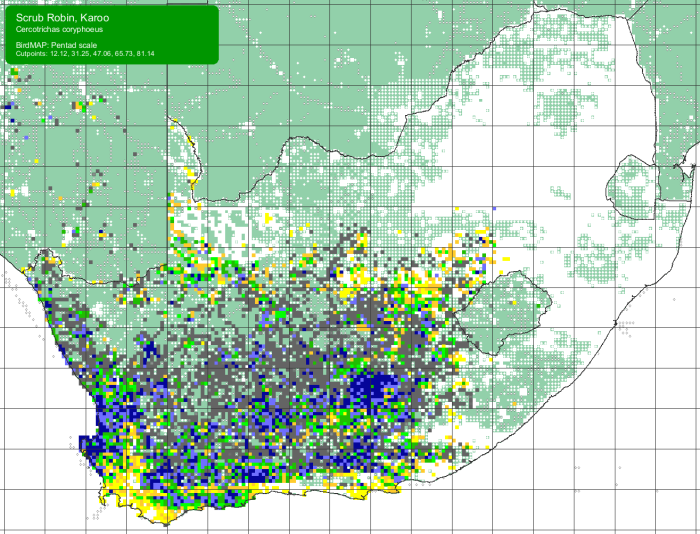Cover image of Karoo Scrub Robin by Ryan Tippett – Carnarvon district, Northern Cape – BirdPix No. 274165
Identification
The Karoo Scrub Robin is overall, a dark, greyish-brown scrub robin with a blackish tail and noticeable white tips. Upperparts are brownish-grey, especially on the wings. The underparts are plain greyish brown with a contrasting whiteish throat. The head is also plain grey-brown but with a conspicuous white supercilium and a thin, dark malar stripe. The sexes are alike.

Rouxville district, Free State
Photo by Dawie de Swardt
Juvenile and immature birds are similar but show buff spotting on the upperparts and are mottled in dark brown and buff below.

Vleesbaai, Western Cape
Photo by Pieter La Grange
The Karoo Scrub Robin is easily recognisable but may be confused with the Kalahari Scrub Robin (Cercotrichas paena) where the ranges of the two species overlap. The Kalahari Scrub Robin is paler below and browner above, with a broader and longer white supercilium. The latter also has a russet-orange (not greyish-brown) upper tail and rump.
Status and Distribution
The Karoo Scrub Robin is a common resident and is endemic to southern Africa. It is confined to the central and western parts of southern Africa, from the Western Cape and throughout the Karoo to the central Free State and across into southern Namibia.

Details for map interpretation can be found here.
Habitat
The Karoo Scrub Robin inhabits Nama and Succulent Karoo scrub, dry fynbos, strandveld, thorny riverine scrub and bushy hillsides. It favours habitats with bare patches between or under dense bushes, around a meter tall. It makes use of farm homestead gardens but seldom enters villages or towns.

Montagu, Western Cape
Photo by Ryan Tippett
Behaviour
The Karoo Scrub Robin is usually encountered solitarily or in pairs. They are rather bold, inquisitive and excitable birds. Perches on the top of a bush or rock when disturbed while flicking its tail and calling loudly. If disturbed further they will fly off into the cover of vegetation with the tail fanned. They readily mob predators, calling harshly and constantly.

Vleesbaai, Western Cape
Photo by Pieter La Grange
The Karoo Scrub Robin forages on the ground or among the low branches of bushes. They run well and will sometimes also hop. The Karoo Scrub Robin feeds mostly on invertebrates with insects making up the bulk of its diet. They also consume worms and small fruits.

Bushmanskloof, Western Cape
Photo by Zenobia van Dyk
The Karoo Scrub Robin breeds from July to January with a peak during October. In drier areas it breeds opportunistically after rain. The nest is a coarse cup composed of sticks, grass and plant stems and is neatly lined with hair, rootlets or plant down.

Tygerberg Nature Reserve, Western Cape
Photo by Gerald Wingate
The nest is usually placed on the ground under a dense bush and is well hidden. 2 to 4 (usually two or three) eggs are laid per clutch. The eggs are pale greenish-blue with brownish-red to purple blotches. All incubation is likely performed by the female and the incubation period lasts for around 15 days, during which time the male supplies her with food. The nestling period lasts another 15 days or so. The young are fed by both parents or sometimes by helpers, mainly with soft-bodied insects, such as termite workers and caterpillars.
Broods of the Karoo Scrub-robin are sometimes parasitised by the Diederik Cuckoo (Chrysococcyx caprius), although this appears to be rare.

Langebaan, Western Cape
Photo by Graham Bull
Further Resources
Species text adapted from the first Southern African Bird Atlas Project (SABAP1), 1997.
The use of photographs by Dawie De Swardt, Gerald Wingate, Graham Bull, Pieter La Grange, Tino Herselman and Zenobia van Dyk is acknowledged.
Virtual Museum (BirdPix > Search VM > By Scientific or Common Name).
Other common names: Slangverklikker (Afrikaans); Agrobate coryphée (French); Karruheckensänger (German); Rouxinol-do-mato do Karoo (Portuguese)
A list of bird species in this format is available here.
Recommended citation format: Tippett RM 2024. Karoo Scrub Robin Cercotrichas coryphoeus. Biodiversity and Development Institute. Available online at https://thebdi.org/2024/03/09/karoo-scrub-robin-cercotrichas-coryphoeus/

Middelburg district, Eastern Cape
Photo by Tino Herselman

